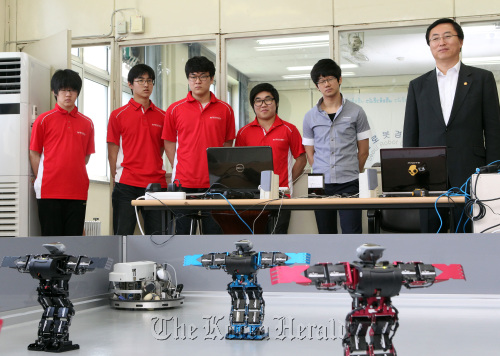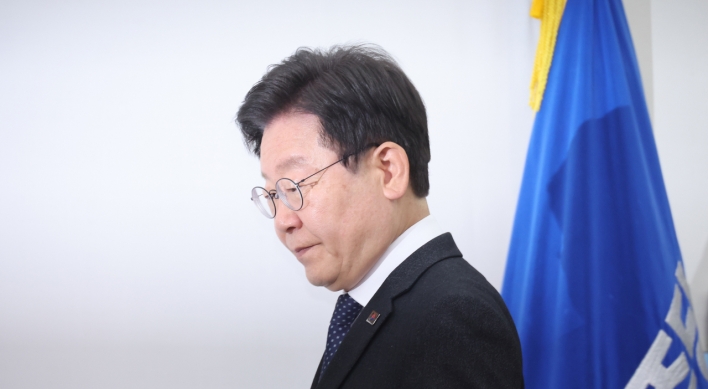Market for robots nearly doubles to 1.93tr won in 2010
Korea’s robotics industry is making rapid headway as local developers chalked up record growth in output, sales and exports last year on the back of surging investment in factories, a government study showed Tuesday.
According to the survey by the Korea Association of Robot Industry of 395 firms, their combined sales nearly doubled to 1.93 trillion ($1.83 billion) last year from a year earlier. Total production volume and exports shot up 75 percent and 137 percent to around 1.78 trillion won and 229 billion won, respectively.
Korea’s robotics industry is making rapid headway as local developers chalked up record growth in output, sales and exports last year on the back of surging investment in factories, a government study showed Tuesday.
According to the survey by the Korea Association of Robot Industry of 395 firms, their combined sales nearly doubled to 1.93 trillion ($1.83 billion) last year from a year earlier. Total production volume and exports shot up 75 percent and 137 percent to around 1.78 trillion won and 229 billion won, respectively.

Of the total output, industrial robots such as for carrying, loading, assembling and welding took the biggest slice with almost 80 percent, up 70 percent compared with 2010.
A spike in facility investment by local manufacturers, coupled with the expanding role of robots on production lines, largely drove up demand, said the Ministry of Knowledge Economy, which compiled the data.
“(The robotics industry) tends to be affected by facility investment because industrial robots are regarded as part of assembly lines,” a ministry official said. “Government subsidies and pilot projects play a big part as well.”
Harnessing Korea’s advanced technologies in electronics and telecommunications, the government has been looking to bolster the nascent sector since 2002 as one of growth engines along with autos, semiconductors and displays.
In January, seven ministries involving industry, education and the environment devised a plan to pump 100 billion won into 10 pilot projects to develop and utilize service and industrial robots by 2013.
Under the plan, robots will be deployed for education, fire-fighting, sewage repairs and manufacturing this year, while others patrol danger zones, remove mines in the DMZ and do farm work starting next year, the Ministry of Knowledge Economy said.
“This pan-governmental plan will be a stepping stone for Korean developers to play a leading role in the coming era of robotics revolution,” said Cho Seok, the ministry’s chief of growth engines division.
The latest study also highlights stellar growth in the service robot market. Though its share is only about 10 percent, the segment expanded by a whopping 562 percent in a year to almost 100 billion won.
Service robots generally assist humans with domestic and office chores and other professional tasks including surgery, navigation, milking, teaching, demining and military patrol operations.
In December, the ministry unveiled a comprehensive package to fund 30 billion won for the commercialization, standardization and marketing for the high value-added helpmates by 2017.
Although it has teetering on the brink of the global economic slowdown, the local robot market has still managed to expand at double-digit rates every year since 2006, according to the state-run Korea Institute for Robot Industry Advancement.
Korea is the world’s No. 4 robot producer after Japan, Germany and the U.S. The International Federation of Robotics projects the global market to reach $100 billion in 2018.
In its annual report, the Frankfurt-based organization picked Korea as the world’s top robot buyer in 2010, with demand almost tripling in a year.
“The most dynamic markets were China, Korea and the ASEAN countries,” it said, noting that robots in the automotive, electronics, food and metal industries are boosting the automation levels in the regions and worldwide.
By Shin Hyon-hee (heeshin@heraldcorp.com)





![[Herald Interview] 'Amid aging population, Korea to invite more young professionals from overseas'](http://res.heraldm.com/phpwas/restmb_idxmake.php?idx=644&simg=/content/image/2024/04/24/20240424050844_0.jpg&u=20240424200058)











![[KH Explains] Korean shipbuilding stocks rally: Real growth or bubble?](http://res.heraldm.com/phpwas/restmb_idxmake.php?idx=652&simg=/content/image/2024/04/25/20240425050656_0.jpg&u=)

